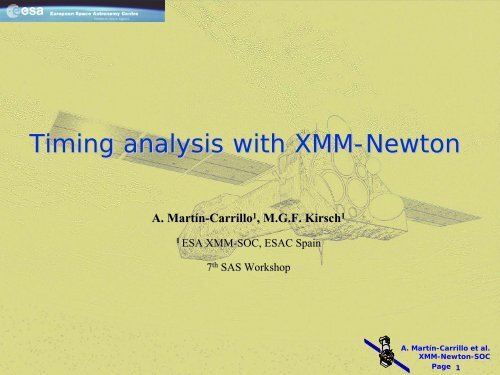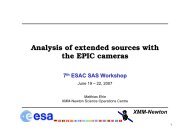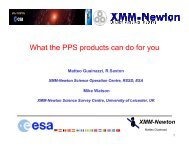You also want an ePaper? Increase the reach of your titles
YUMPU automatically turns print PDFs into web optimized ePapers that Google loves.
<strong>Timing</strong> <strong>analysis</strong> <strong>with</strong> <strong>XMM</strong>-<strong>Newton</strong>A. Martín-Carrillo1 , M.G.F. Kirsch 11ESA <strong>XMM</strong>-SOC, ESAC Spain7 th SAS WorkshopA. Martín-Carrillo et al.<strong>XMM</strong>-<strong>Newton</strong>-SOCPage 1
menu• relative timing of <strong>XMM</strong>-<strong>Newton</strong>– EPIC-pn modes for timing <strong>analysis</strong>– accuracy• timing <strong>analysis</strong> proceeding– example: the Crab pulsarA. Martín-Carrillo et al.<strong>XMM</strong>-<strong>Newton</strong>-SOCPage 2
elative timing accuracy• the relative timing accuracy is measure as follows:ΔP=PPR−PPRXrelative error• where P r means the radio period taken as reference and P xthe X-ray period obtained using <strong>XMM</strong>-<strong>Newton</strong> data• the relative timing accuracy of the EPIC-pn camera usingall the Crab observations since 2000 is:ΔPP
some famous pulsars• the Crab emits in all wavelengths and its pulse profile isvery similar in all of themA. Martín-Carrillo et al.<strong>XMM</strong>-<strong>Newton</strong>-SOCPage 5
the Crab pulsar• technical information:– distance: 2200 pc– RA: 05 34 31.97– DEC: +22 00 52.1– L~5 x 10 38 erg/sec– L X ~4.9 x 10 37 erg/sec– P ~ 33.1 ms– Pdot ~ 36 ns/dPalomar180 arcsec120 arcsec• pulsar discovery by Staelin and Reifenstein 1968 in radio• 1963 Gurskey discovered X-ray source in Taurus region• high energy Crab is smaller than low energy Crab(Staubert 75)A. Martín-Carrillo et al.<strong>XMM</strong>-<strong>Newton</strong>-SOCPage 6
the Crab pulsar (II)<strong>XMM</strong>-EPIC-pnAstro-1Shuttle PayloadChandraNRAOA. Martín-Carrillo et al.<strong>XMM</strong>-<strong>Newton</strong>-SOCPage 7
creating the events file: epproc• run cifbuild and odfingest• run epproc setting timing and burst parameters as YES• give the RA and DEC coordinates of the source in decimaldegrees (really important in off set observations):– example (PSRB 1509):• srcra=228.4817917 srcdec=-59.13583333A. Martín-Carrillo et al.<strong>XMM</strong>-<strong>Newton</strong>-SOCPage 9
arycentric correction: barycen• correction of photon arrival time to the solar barycenteras a reference pointA. Martín-Carrillo et al.<strong>XMM</strong>-<strong>Newton</strong>-SOCPage 10
selecting the source• in burst mode do not select the wholecolumn.• in timing and burst modes take the RAWXand RAWY coordinates.(RAWX,RAWY) IN box(36.75,100.75,6.75,96.75,0)• important: in small window observationstake the DETX and DETY coordinates.A. Martín-Carrillo et al.<strong>XMM</strong>-<strong>Newton</strong>-SOCPage 11
searching the period: powspec• power spectral density for one time series• spectrum is computed using Fourier algorithm• output is power versus frequencyFourier transformationratepowertimefrequencyA. Martín-Carrillo et al.<strong>XMM</strong>-<strong>Newton</strong>-SOCPage 12
folding the data: efoldrate+time+phase0.5 - 10 keVA. Martín-Carrillo et al.<strong>XMM</strong>-<strong>Newton</strong>-SOCPage 13
determining the period: efsearch• fold the data over a range of test periods, P i :IntensityP 3P 2P 1First trial: radio periodTimeefsearch• for each test period determine χ 2 of the fit of the foldedlight curve vs. a uniform distribution:Good periodHigh χ 2Bad periodLow χ 2A. Martín-Carrillo et al.<strong>XMM</strong>-<strong>Newton</strong>-SOCPage 14
final result• typical result of a χ 2 test for one observation of theCrab pulsarSIGNALNOISEA. Martín-Carrillo et al.<strong>XMM</strong>-<strong>Newton</strong>-SOCPage 15
esumeinput listepproc data barycensourceregionxmmselectcorrected dataefoldpowspecsource dataPERIODpulseprofiletrial periodefsearchA. Martín-Carrillo et al.<strong>XMM</strong>-<strong>Newton</strong>-SOCPage 16






